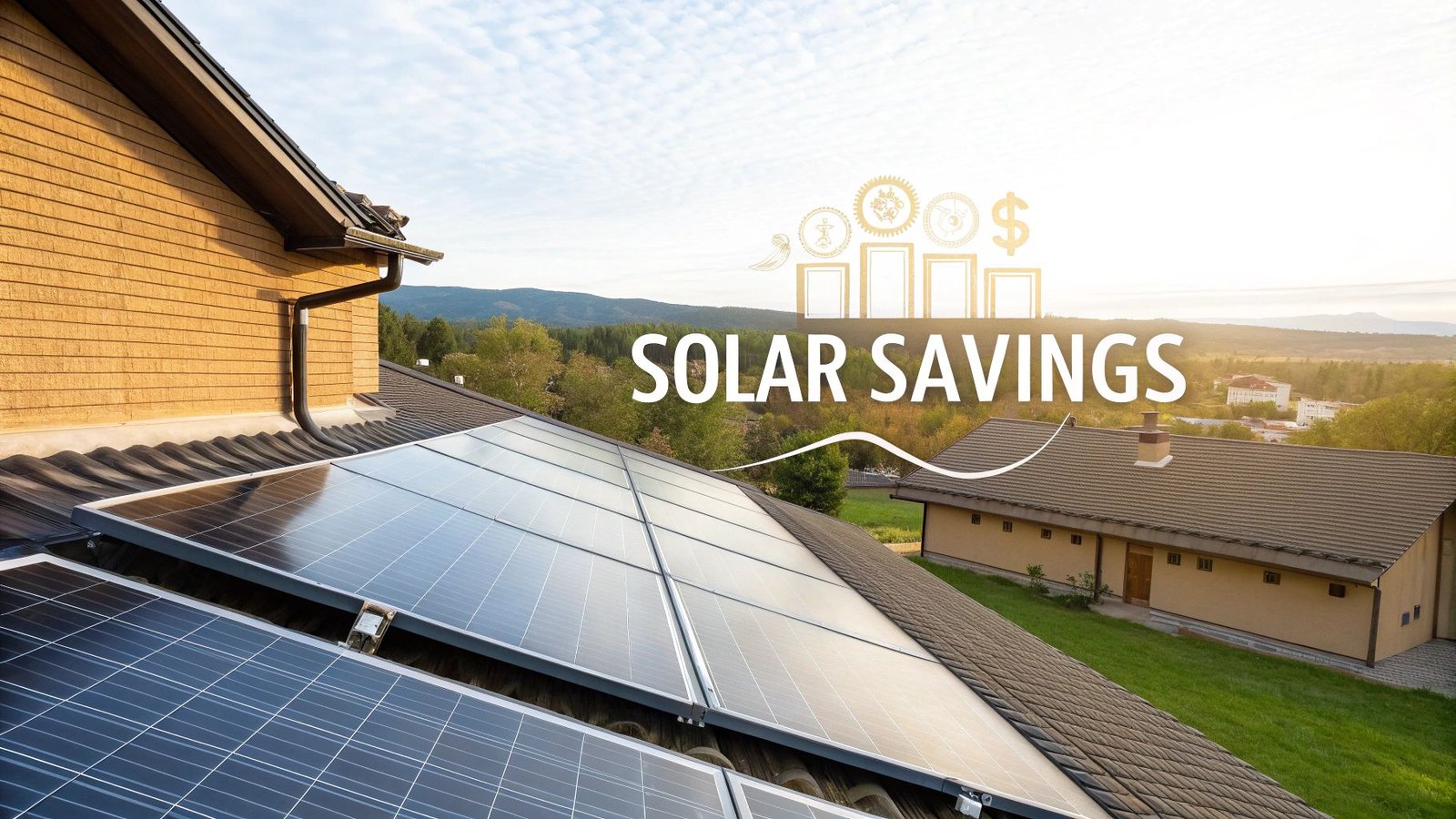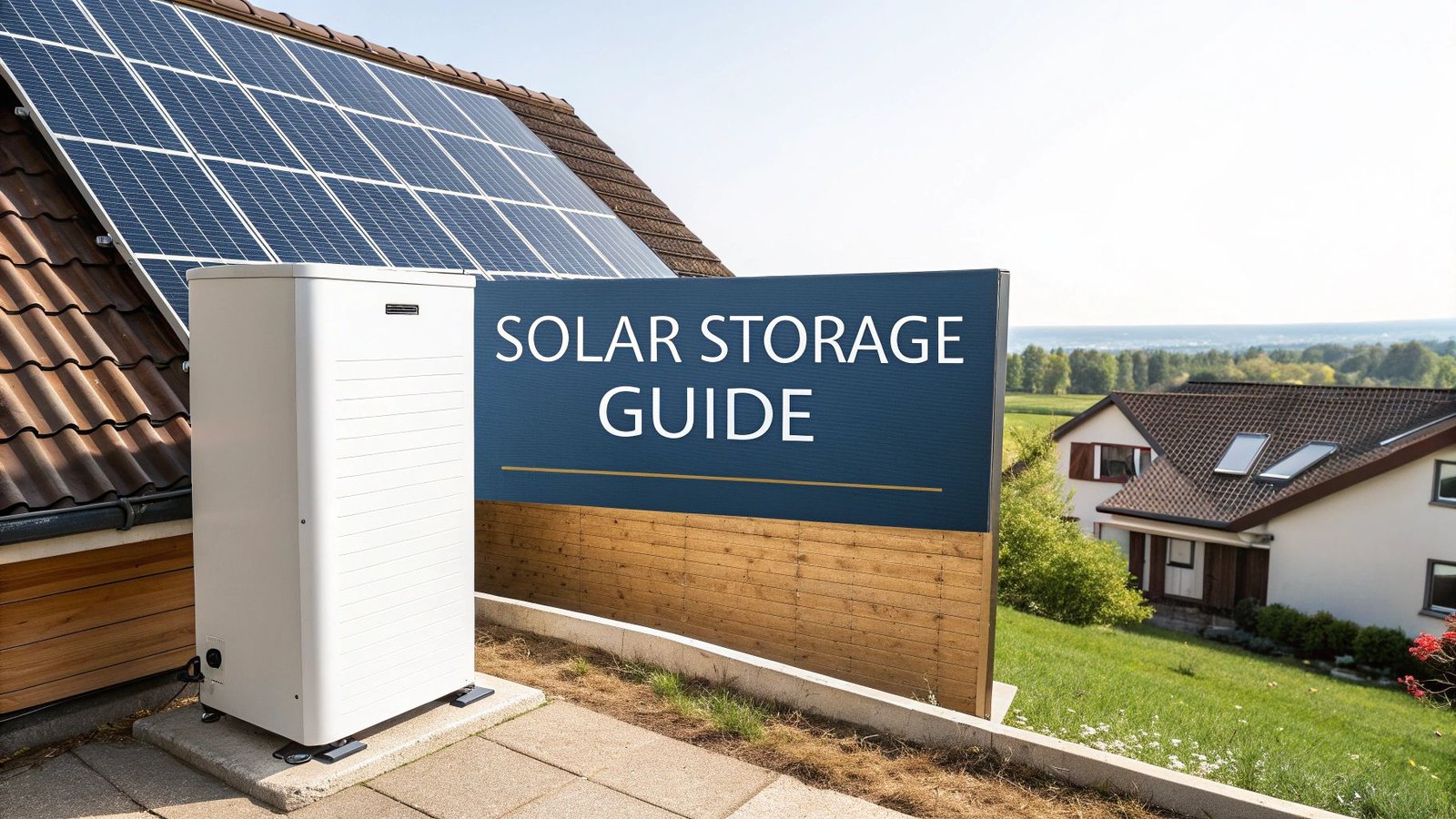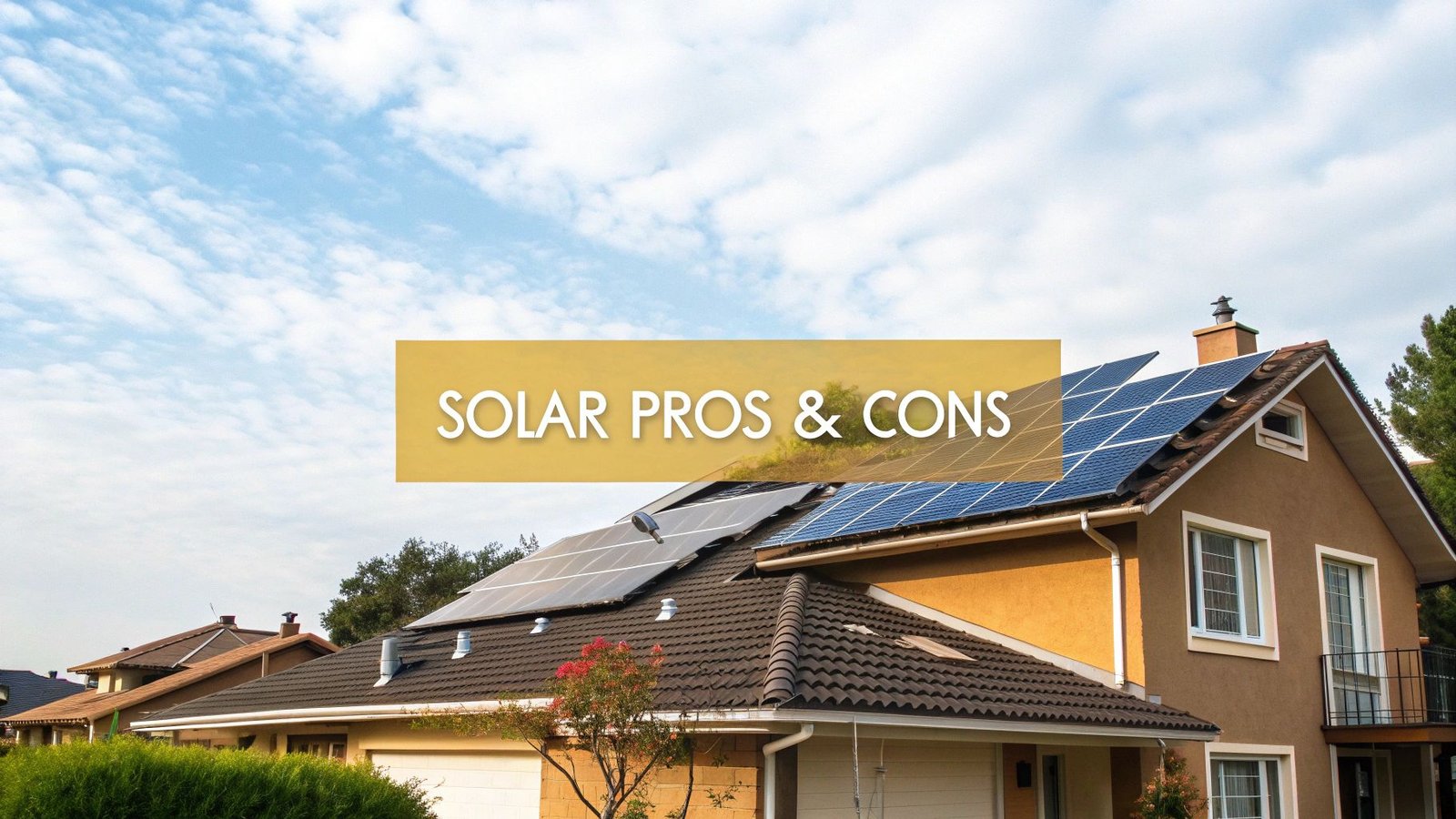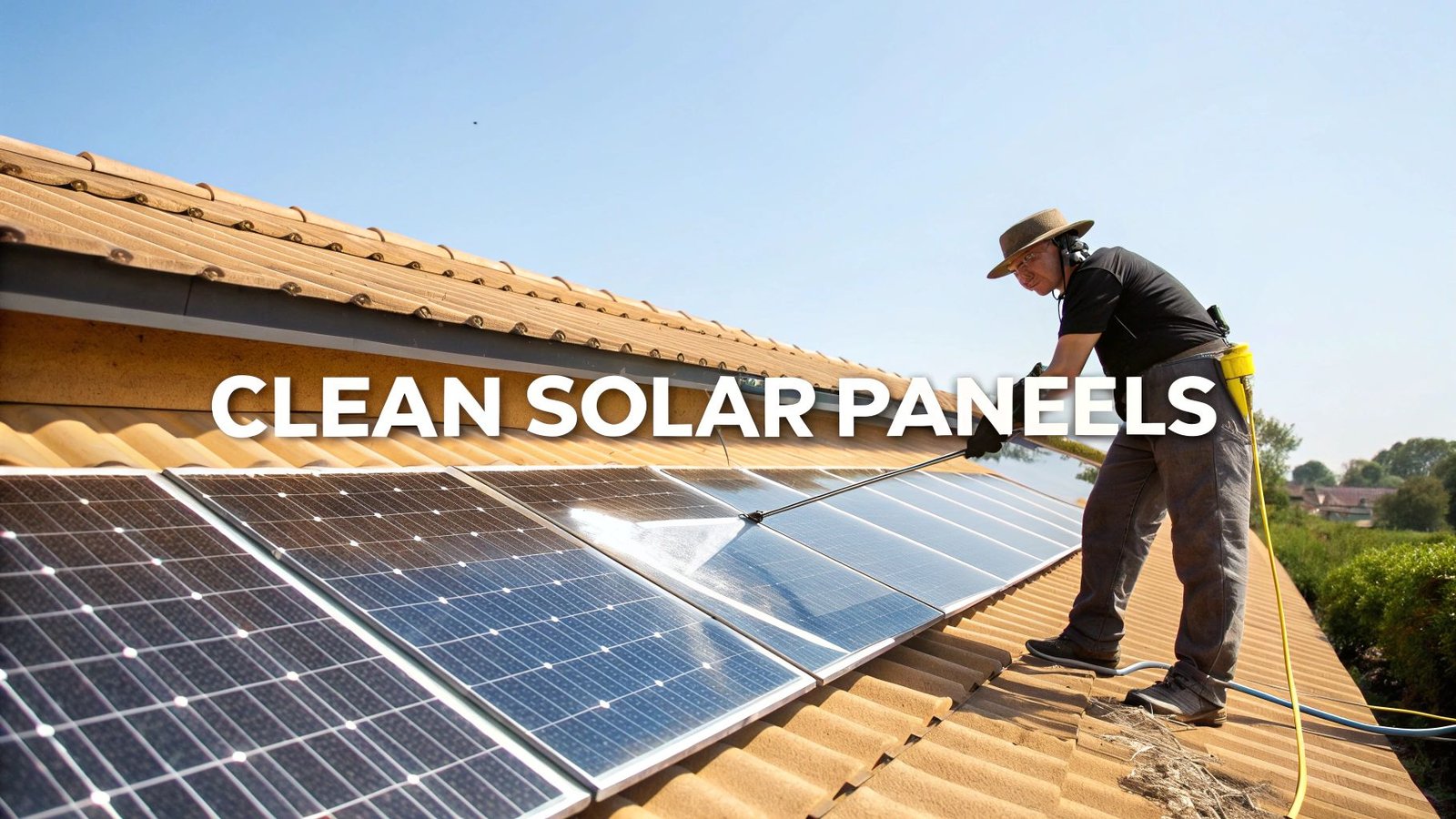For most homeowners weighing the options, the answer to "are solar panels worth it?" is increasingly a clear yes. It's easy to get fixated on the initial price tag, but it's more helpful to see it as a long-term play—swapping a volatile, unpredictable utility bill for clean energy you generate yourself.
Of course, the real value isn't one-size-fits-all. It really comes down to your unique situation.
The Real Value of Your Solar Investment
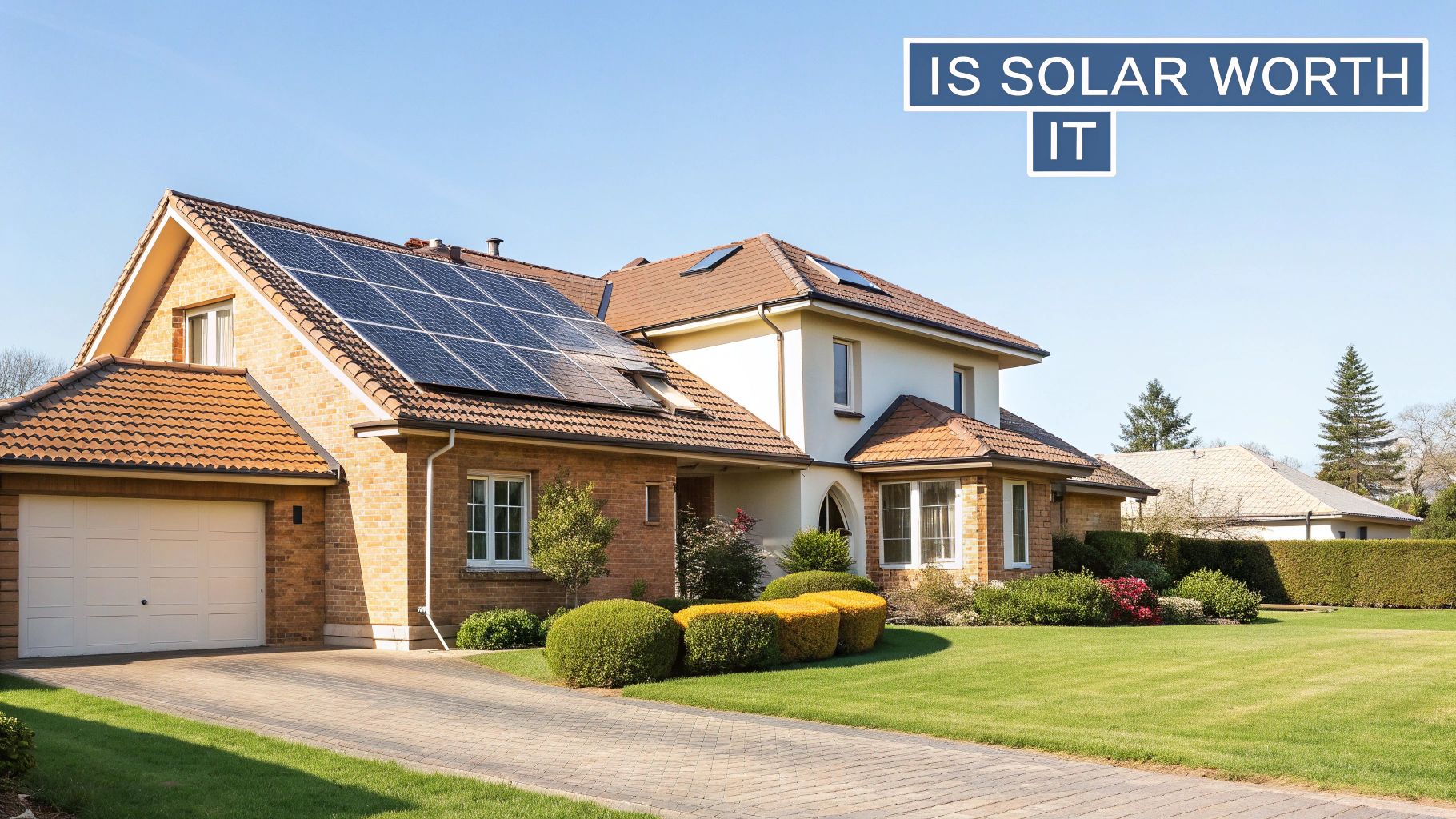
Figuring out if solar panels make financial sense for you is less about a gut feeling and more about running the numbers. The "worth" of a solar system isn't some abstract concept; it's a direct result of a handful of key factors specific to your home and where you live.
Here’s a practical way to think about it: going solar is like prepaying for decades of electricity at today's prices. You're effectively locking in your energy costs, insulating yourself from the inevitable rate hikes your local utility will roll out over the years. The immediate goal is to hit your payback period—the point where the money you've saved on electricity bills completely covers what you spent on the system.
The financial argument for solar has become incredibly compelling. The cost for large-scale solar projects dropped by a staggering 80% between 2010 and 2020. For homeowners, that price drop means you can often produce your own power for 30–50% less than what the utility charges. It's no wonder payback periods are now frequently under 7 years. You can discover more insights about solar energy statistics on enkonnsolar.com.
Your Personal Solar Equation
To really get to the bottom of whether solar is a smart move for your home, you have to look at a few critical variables. Each one has a major impact on how quickly you'll break even and, more importantly, how much you'll save over the 25-year-plus lifespan of your panels.
It's the combination of these elements that defines your savings potential:
- Your monthly power bill: The more you're currently paying, the more you have to gain.
- How much sun your roof gets: A south-facing roof with clear, all-day sun is the ideal.
- Local electricity prices: High-cost areas see a much faster return on their solar investment.
- Available incentives: Government perks like tax credits can dramatically lower your net cost.
To simplify things, here’s a quick-glance table to help you see if your home is a prime candidate for solar savings.
Key Factors That Determine Your Solar Savings
| Factor | Por qué es importante | Ideal Scenario For Savings |
|---|---|---|
| Local Electricity Rates | The more expensive grid power is, the more valuable each kilowatt-hour you generate becomes. This accelerates your payback period. | You live in a state where electricity costs are higher than the national average (think California, Hawaii, or the Northeast). |
| Sun Exposure (Solar Irradiance) | Your system's output is directly tied to how much direct, unobstructed sunlight hits your roof. More sun means more power. | Your roof faces south or west with little to no shade from trees, chimneys, or neighboring buildings, especially during peak hours. |
| Government Incentives | These act as a direct discount on your installation. The less you pay upfront, the faster you break even. | You can claim the full Crédito fiscal federal 30% and stack it with additional state, local, or utility-specific rebates. |
| Net Metering Policies | This policy lets you "sell" surplus power back to the grid for credits, essentially turning your utility into a giant battery. | Your utility offers a strong, one-to-one net metering program, crediting you the full retail rate for your excess energy. |
Looking at these four factors together gives you a pretty solid picture of what to expect. If you check off most of these boxes, solar is very likely a fantastic financial decision for you.
Understanding the Real Cost of Going Solar
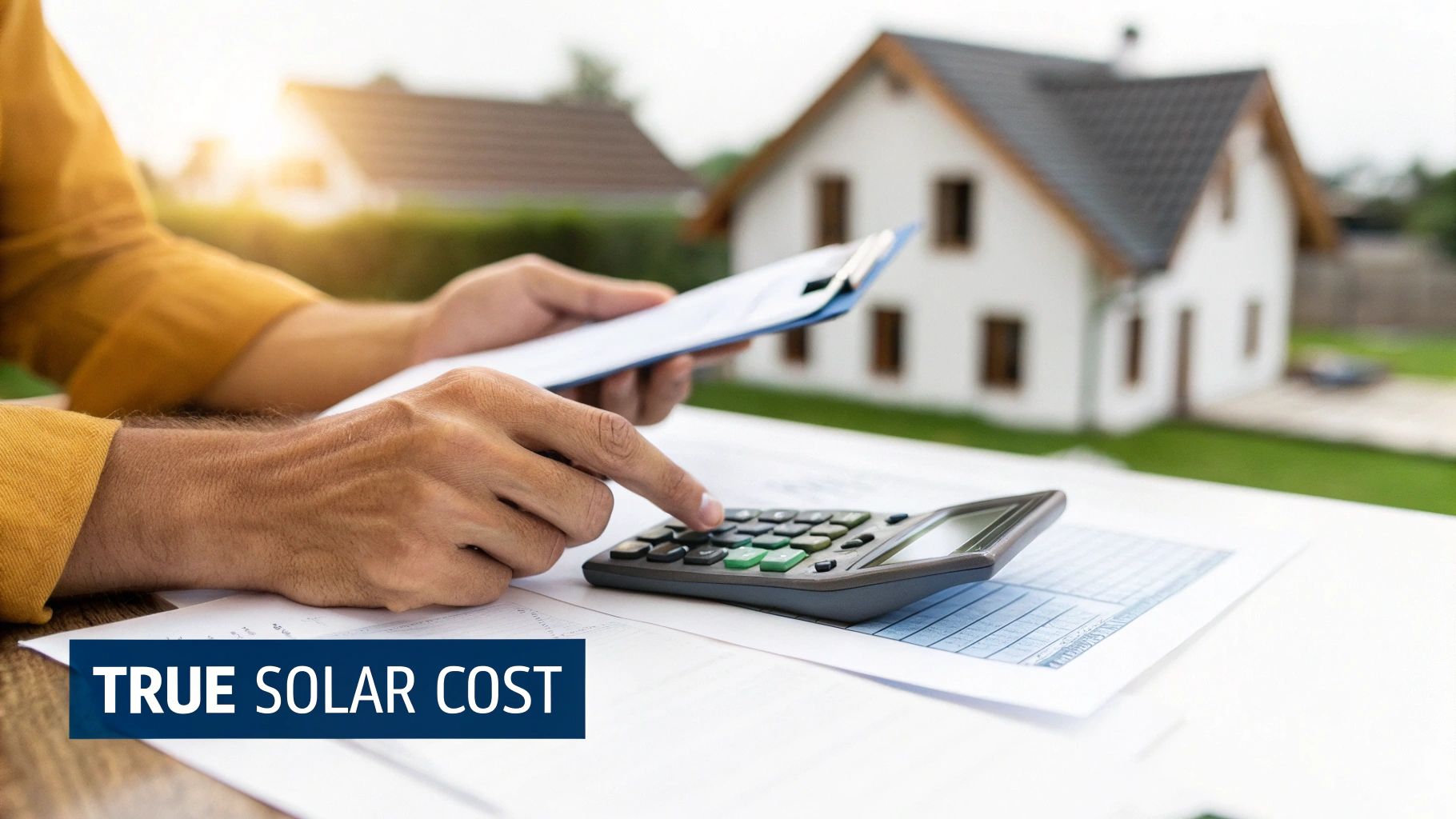
When people ask if solar is worth it, the first thing they usually look at is the price of the panels themselves. But that's only part of the picture. The true upfront cost is a mix of hardware, the skilled labor to install it, and all the behind-the-scenes work that brings your home’s new power plant to life.
Think of it like buying a car. You don't just pay for the engine; you're paying for the chassis, the electronics, the seats, and the work that went into assembling it all. A solar system is much the same—it's more than just a pile of panels.
The Hardware You Can See
The most obvious part of your investment is the equipment you see on your roof. This is what everyone imagines when they think about “going solar,” and it generally makes up about a third of the total project price.
These are the core components:
- Solar Panels: These are the workhorses, grabbing sunlight and turning it into DC (direct current) electricity. The brand, efficiency, and the total number of panels you need will all affect the cost.
- Inverters: This is the brains of the whole operation. The inverter’s critical job is to convert that DC electricity into the AC (alternating current) that your home’s appliances and the power grid actually use.
- Racking and Mounting: This is the rugged skeleton that holds the panels firmly to your roof. A high-quality racking system is non-negotiable; it protects both your panels and your home for decades.
While these are the foundational pieces, they’re really just the beginning of the story. The rest of the cost comes from the expertise and services needed to get everything working perfectly.
Unpacking the 'Soft Costs' of Solar
You'll often hear installers talk about "soft costs." These are all the necessary non-hardware expenses, and they can surprisingly account for as much as 65% of your total bill. This is where a lot of the real work happens.
While the price of solar panels has plummeted over the past decade, the soft costs—things like labor, permits, and design—haven't dropped nearly as fast. That’s why the all-in price of a solar installation hasn't fallen at the same dramatic rate as the hardware itself.
So, where does that money actually go?
- Trabajo: This pays for the certified electricians and installers who safely mount everything, run the wiring, and hook the system into your home's main electrical panel.
- Permitting Fees: Before a single panel goes up, your installer has to submit detailed plans to your local city or county for approval. These fees can vary a lot from one town to the next.
- Inspection and Interconnection: Once the work is done, your local inspector and the utility company have to sign off on the system before you can officially flip the switch and connect to the grid.
- Engineering and Design: A team creates a custom blueprint for your specific roof, making sure the layout maximizes sun exposure and energy production.
And don't forget your roof itself. Before you commit, it’s a smart move to get a professional roof inspection. Finding out you need roof repairs mid-project can be a costly and frustrating surprise.
Realistic Cost Ranges for Your Home
So, what’s the bottom line? For most homeowners in the U.S., a residential solar panel system will land somewhere between $15,000 and $30,000 before any rebates or tax credits. The final number really boils down to the size of the system you need to cover your energy usage.
Here’s a rough breakdown of what you might expect for common system sizes:
- Small System (5 kW): Good for smaller homes or those with low electricity bills. This typically runs from $13,000 to $18,000.
- Medium System (8 kW): This is the sweet spot for many average-sized American homes, usually costing between $20,000 and $28,000.
- Large System (12 kW): For bigger homes with higher energy needs (think electric vehicle chargers or pools), the cost could be $30,000 or more.
For a deeper dive into the numbers, check out our complete guide to coste de instalación de un sistema de paneles solares. Just remember, these are the starting figures. The federal solar tax credit and local incentives can take a serious chunk out of that final price, which we’ll cover next.
Calculating Your Solar Payback and Long-Term ROI
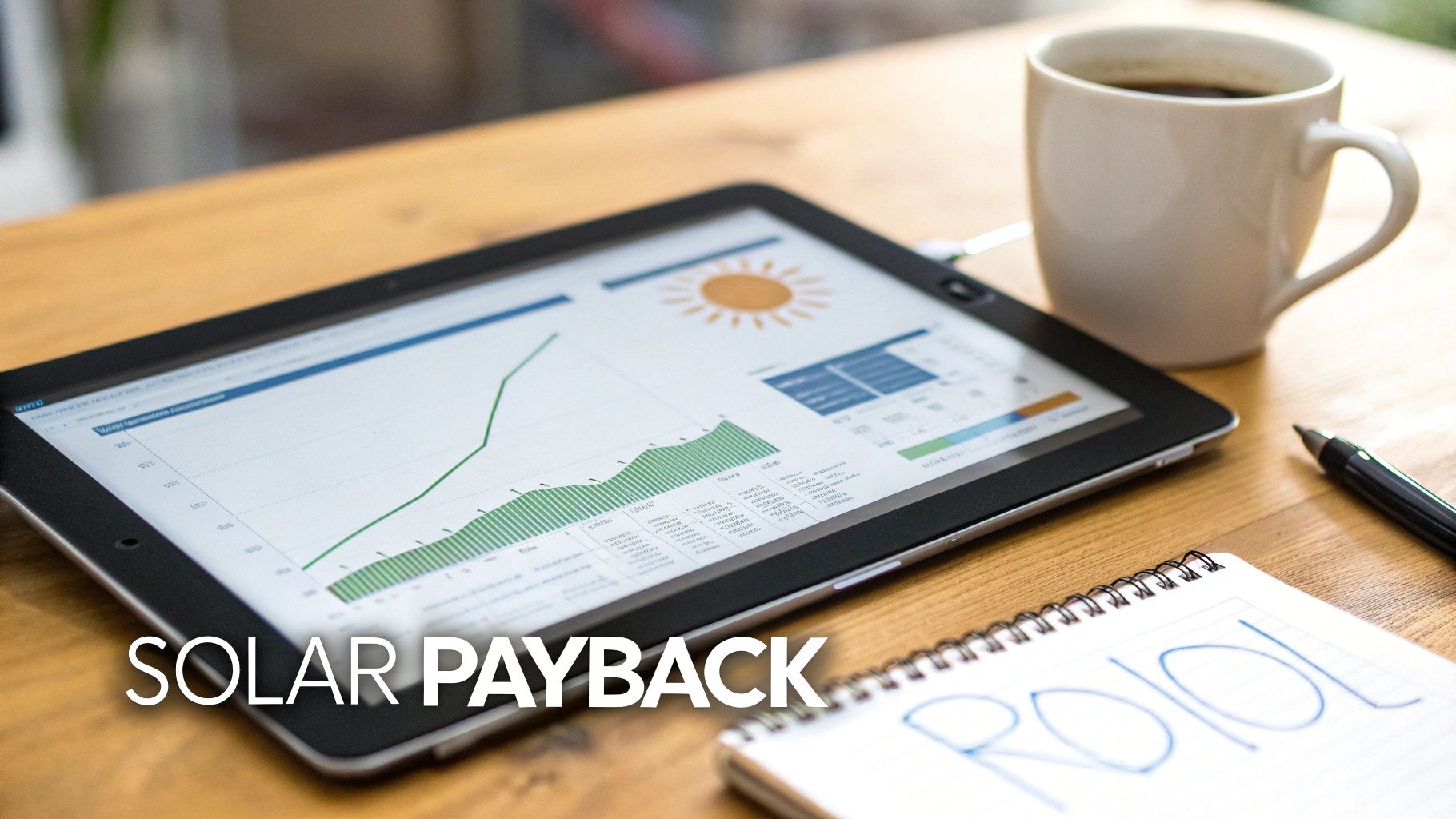
Alright, now that we've covered the total cost, let's get to the fun part: figuring out when your solar panels start paying you. The real question isn't just about the price tag; it's about the entire financial journey.
To make sense of it all, we need to look at two key ideas: the solar payback period and the Return on Investment (ROI).
Think of the payback period as the finish line for your initial investment. It's the moment when your accumulated energy savings officially cancel out the cost of the system. Every day after that? Pure profit.
ROI, on the other hand, is the big picture. It tells you the total financial gain you can expect over the entire 25-plus-year life of your panels. Payback tells you cuando you break even; ROI tells you how much money you'll make in the long run.
Pinpointing Your Solar Payback Period
Calculating your payback period is actually pretty straightforward. It just boils down to pitting your upfront cost against your annual savings.
The basic formula is simple:
Total System Cost (after incentives) ÷ Annual Electricity Savings = Payback Period in Years
Let's walk through an example. Say your total system cost is $22,000. After you claim the Crédito fiscal federal 30% ($6,600), your actual out-of-pocket cost drops to $15,400.
If you were paying about $150 a month for electricity before going solar, that’s $1,800 a year you're no longer sending to the utility company.
So, the math looks like this: $15,400 ÷ $1,800 = 8.55 years.
In this scenario, your system pays for itself in just over eight and a half years. For the next 16+ years of the warranty, you’re essentially getting free power.
The Factors That Speed Up Your Payback
Of course, that 8.5-year timeline isn't set in stone. Several factors can really put the pedal to the metal and shorten your payback period, making solar an even smarter move.
- Rising Utility Rates: Every time your power company hikes its rates, your savings get bigger. The faster electricity prices climb, the faster you get to your break-even point.
- Government Incentives: Tax credits and rebates are designed to slash your initial cost. The federal Investment Tax Credit (ITC), for instance, gives you a 30% credit on your system's cost through 2032. It’s a huge reason why states like California had over 10.5 million solar-powered homes by 2024.
- Net Metering: This is a big one. Good net metering policies let you sell your excess solar energy back to the grid for credits. Those credits directly reduce what you owe for any power you pull from the grid at night, accelerating your savings.
Want to get a better idea of your specific numbers? Our solar return on investment calculator can give you a much more personalized estimate based on your home and energy use.
Looking Beyond Payback to Lifetime ROI
Breaking even is a great milestone, but the real financial magic happens después de that point. This is when your solar system stops being an expense and starts acting like a money-making asset on your roof.
Let's stick with our example to calculate the long-term ROI over a 25-year system lifespan.
Here’s how it adds up:
- Total Electricity Savings: $1,800 per year x 25 years = $45,000
- Net Profit: $45,000 (Total Savings) – $15,400 (Net System Cost) = $29,600
- Total ROI: ($29,600 ÷ $15,400) x 100 = 192%
A 192% return on investment is phenomenal—far better than what you’d see from many traditional investments over that same timeframe. This simple math makes it clear: the true value of solar is unlocked over the long haul.
How Incentives Can Supercharge Your Solar Savings
When you'sre looking at the price tag for a new solar panel system, you're only seeing half the picture. The real story includes the powerful financial incentives that can slash your upfront cost and dramatically shorten the time it takes to see a return on your investment.
Think of these programs as a huge discount coupon for going green. They're designed to make clean energy a no-brainer for more homeowners, and by taking advantage of them, you can make the answer to "are solar panels worth it?" a resounding "yes."
The Federal Solar Investment Tax Credit
The biggest and most important incentive for almost any homeowner in the U.S. is the Residential Clean Energy Credit. You'll often hear it called the Solar Investment Tax Credit, or ITC. This isn't just a simple deduction from your income—it's a powerful, dollar-for-dollar credit that directly reduces the federal income tax you owe.
Right now, the ITC lets you claim 30% of the total cost of your solar system. So, if your system costs $25,000, this incentive puts a cool $7,500 right back in your pocket when you file your taxes. This one program alone can chop nearly a third off your net cost, making it the single most effective tool for boosting your solar ROI.
State and Local Incentives: The Extra Savings Layer
The good news doesn't stop with the federal credit. A whole landscape of state, local, and even utility-specific programs can be stacked on top for even more savings. What's available varies a lot depending on where you live, so a little local research is key.
These programs usually come in a few different flavors:
- Reembolsos en efectivo: Some states or utility companies will literally send you a check after your system is installed. It's a simple, direct way to lower your initial out-of-pocket expense.
- Incentivos basados en el rendimiento (PBI): In some areas, you can actually earn money based on how much power your panels generate. Programs like Solar Renewable Energy Credits (SRECs) let you sell credits for your clean energy production back to the utility.
- Créditos fiscales estatales: Just like the federal ITC, some states have their own tax credits. If you're lucky enough to live in one of these states, you can claim both and double down on the tax benefits.
Imagine this: you take the Crédito fiscal federal 30% and combine it with a state rebate of, say, $3,000. Suddenly, your net cost on that $25,000 system plummets from $25,000 all the way down to just $14,500. It's easy to see how layering these incentives can make solar much more affordable.
This chart really drives home how much of a difference these programs can make.
The Power of Net Metering
Por último, tenemos net metering, a billing arrangement that might just be the unsung hero of solar savings. This is the mechanism that ensures you get full credit for every single kilowatt-hour your panels produce.
Here's how it works: on a bright, sunny afternoon, your panels are often cranking out more electricity than your home needs at that moment. With net metering, that extra power is automatically sent to the grid, and your utility company credits your account for it. It's almost like watching your electric meter spin backward.
Later that night or on a cloudy day, when you need to draw power from the grid, you'll use up those credits first before you have to pay for any electricity. For many homeowners, this system allows them to offset 100% of their electricity costs over the course of a year, making sure no solar energy is ever wasted. A strong net metering policy is one of the biggest reasons solar panels are such a great investment in so many states.
The Hidden Benefits Beyond Your Electric Bill
While saving money is often what gets homeowners thinking about solar, the real value runs much deeper than just a lower utility bill. When you ask, "Are solar panels worth it?" you're tapping into a much bigger picture—one that involves a cleaner planet and a more stable energy future for all of us.
The most obvious perk is the environmental one, and the numbers are impressive. A standard residential solar system can offset the same amount of CO2 as planting over 150 trees each year. That's a real, measurable impact. Your home stops being just a consumer and becomes a tiny power plant, actively cleaning up the air.
Building a Stronger and More Independent Energy Grid
Your solar panels don't just help the planet; they also strengthen your local community's power infrastructure. This is a big deal. Residential solar helps create a more resilient and decentralized power grid.
Think of the old-school grid like a single, giant power station trying to serve thousands of homes. If something goes wrong there, everyone's lights go out. Solar homes flip that model on its head by creating a network of small, independent power sources. This takes a massive load off the central grid, especially during those scorching summer afternoons when everyone's AC is blasting.
A more distributed grid is a more reliable grid. By generating power right where it's used, residential solar reduces the risk of widespread outages and helps stabilize the energy supply for your entire neighborhood.
This isn't just a local trend; it's a global shift. In 2024, solar is projected to account for about 7–8% of worldwide electricity. That’s a huge leap from less than 3% back in 2019. This incredible growth shows just how much individual homeowners are contributing to a stronger, more secure energy system for everyone. You can read the full research about these energy trends.
Gaining Personal Energy Independence
There's also a powerful sense of self-reliance that comes with generating your own power. Now, it's true that a standard grid-tied solar system will shut down during a blackout for safety reasons.
But if you pair your panels with a battery, you create your own personal power reserve. When the grid goes down, your lights, fridge, and other essentials can stay on. Our guide on battery backup systems for homes walks you through how this setup gives you true peace of mind.
Finally, going solar often inspires a broader look at home efficiency. Once you start producing your own clean energy, you naturally become more interested in concepts like passive solar design principles, which can make your home even more comfortable and sustainable. These "hidden" benefits are what turn a smart financial decision into a truly rewarding one.
So, What's the Final Verdict? Are Solar Panels a Good Investment for You?
We've crunched the numbers, explored the savings, and uncovered some of the hidden benefits. Now, it all comes down to the big question: are solar panels actually worth it for you? The honest answer is, it depends. There’s no one-size-fits-all solution here. The real value of going solar is a personal equation that weighs your home's unique situation against your own financial and environmental priorities.
Ultimately, the decision really hinges on a few key factors we've covered. How much direct sunlight does your roof get? What does your monthly electricity bill look like? And, crucially, what local incentives can you tap into? If you're in a sunny state with sky-high utility rates and generous government programs, the financial argument for solar is often a slam dunk.
A Visual Guide to Your Decision
To help you sort through it all, this decision tree lays out the main benefits that make up solar's total value. It’s about more than just what you save on your power bill.
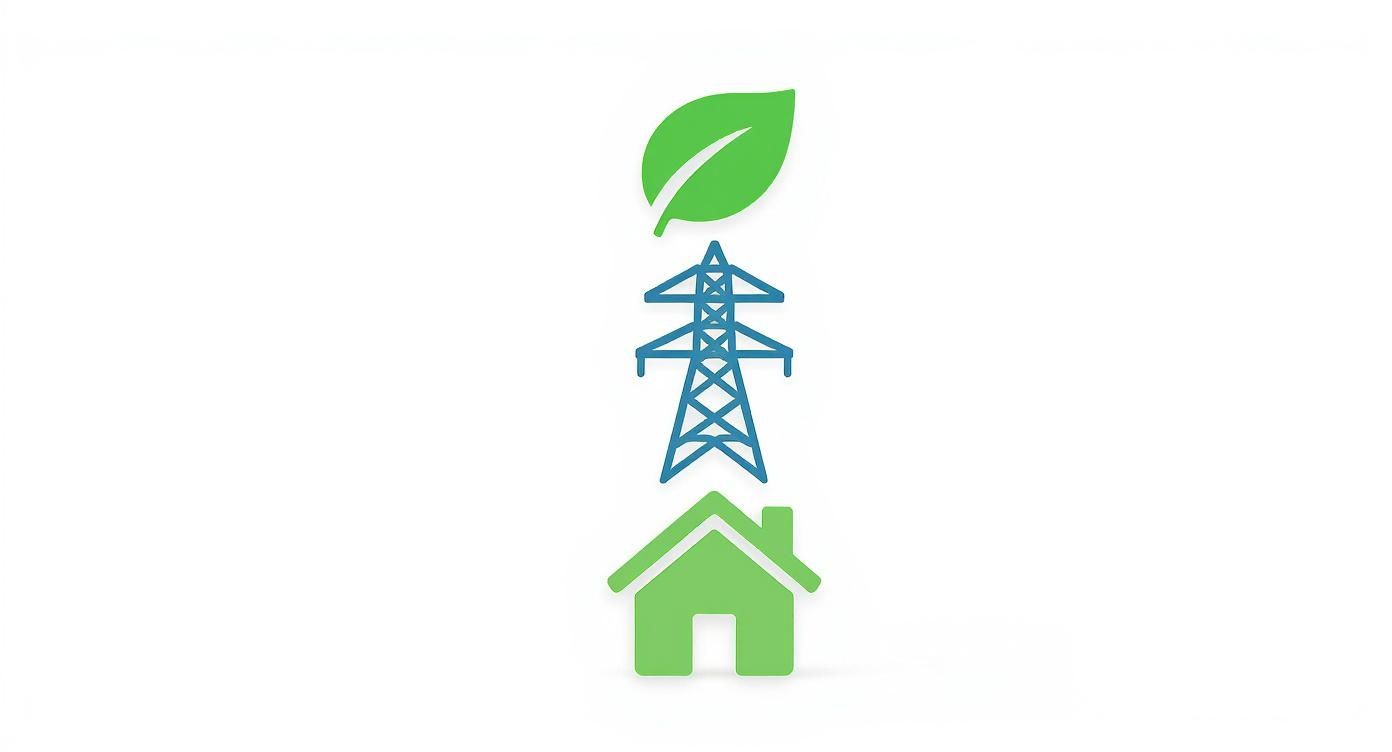
As you can see, this investment pays off in several different ways—from making your home more attractive to future buyers to helping create a cleaner, more reliable energy grid for your entire community.
Your Next Steps on the Path to Solar
If the signs are pointing to yes, your next move is to get some hard numbers for your specific home. The global solar market is absolutely booming, with capacity expected to double in just two years to hit 2,2 teravatios (TW) by the end of 2024. This massive growth—from a $189.5 billion industry in 2022 to a projected $607.8 billion by 2030—is fantastic news for homeowners, as it's driven panel technology forward while making it more affordable than ever. You can discover more insights about the top countries leading in solar power on perfectsenseenergy.com.
Now it’s time to bring those big-picture trends down to your own rooftop by getting quotes from qualified local installers. Here’s what you should be doing:
- Get Multiple Quotes: Don't just talk to one company. Aim for at least three different proposals so you can compare everything—costs, equipment, and warranties. This is the best way to get a competitive price and find a team you trust.
- Read the Proposal Carefully: A good proposal is much more than just a final price. It should give you a detailed breakdown of the system size, the exact models of the panels and inverters, a solid estimate of how much energy it will produce, and a clear explanation of all the warranties involved.
- Check Certifications and Reviews: Look for installers who are certified by reputable organizations like the North American Board of Certified Energy Practitioners (NABCEP). Beyond that, dive into customer reviews on independent sites to get a real feel for their workmanship and customer service.
By taking these concrete steps, you can stop wondering "Are solar panels worth it?" and start knowing, with confidence, exactly what the answer is for your home.
Answering Your Top Solar Questions
Once you’ve crunched the numbers and seen the potential savings, the practical, day-to-day questions start to pop up. What is it really like to live with solar panels? Getting these final details straight is key to feeling confident about making the switch.
Let's walk through the most common questions we hear from homeowners who are on the home stretch of their decision.
How Long Do Solar Panels Last and What's the Upkeep?
Today's solar panels are built like tanks. They're designed to take a beating from the elements—hail, heavy rain, high winds, you name it—and keep on generating power. You can expect them to have a productive life of De 25 a 30 años, backed by a performance warranty.
The best part? They’re incredibly low-maintenance. For most people, a simple cleaning now and then to wash off any pollen, dust, or grime is all it takes to keep them working at their best.
A standard warranty will guarantee that your panels still produce at least 80-90% of their original power after 25 years. That’s a long-term return you can count on.
Do Solar Panels Genuinely Increase My Home's Value?
Absolutely. Study after study confirms that owning a solar panel system adds real, measurable value to your home. On average, homes with solar sell for more and don't sit on the market as long as their non-solar counterparts.
The key word here is "owned." When you own the panels, they're an asset, just like a brand-new kitchen or a remodeled bathroom. Leased systems, on the other hand, don't provide the same financial upside and can sometimes add a wrinkle to the home-selling process.
What Happens When My Panels Make More Power Than I'm Using?
On a bright, sunny afternoon, your system will probably generate more electricity than you need. This extra power doesn't just disappear. Thanks to a clever system called net metering, it gets sent back to the grid for your neighbors to use.
Think of it like banking. You're "depositing" energy credits with your utility company. Later, at night or on a cloudy day when your panels aren't producing, you "withdraw" that energy. This is how many homeowners are able to zero out their electricity bills over the course of a year.
Can I Go Completely Off-Grid with Solar?
Going completely off-grid is the ultimate dream for some, but it’s a much bigger leap than a standard installation. To cut ties with the utility entirely, you need a robust battery storage system to keep your lights on through the night and during long stretches of bad weather.
This level of energy independence comes with a significantly higher upfront cost and requires more complex equipment. That's why the vast majority of homeowners find that a grid-tied system offers the perfect blend of savings, reliability, and affordability—you get the benefits of solar without the premium price tag of a fully off-grid setup.
En Energía radiante, our mission is to make your shift to solar as smooth and beneficial as possible. Our team takes care of everything from the initial design to the final installation, making sure you get a system that delivers maximum value. Explore our solar solutions and get your free quote today.

